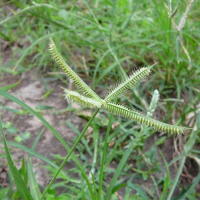Egyptian crowfoot grass
Dactyloctenium aegyptium
Appearance:
- Egyptian crowfoot grass typically grows as a low-lying, prostrate annual grass.
- The stems are slender and can vary in length, with a sprawling or mat-forming growth habit.
- The leaves are linear and can be up to 6 inches (15 cm) long. They are typically light green in color.
Inflorescence:
- Egyptian crowfoot grass produces distinctive seed heads, known as inflorescences.
- The seed heads consist of multiple slender spikes radiating outwards from a central point, resembling a crow's foot or a hand with extended fingers. This unique appearance is the source of its common name.
- The seeds are small and can be sharp or spiny, making them problematic for livestock and causing skin irritation.
Habitat:
- This weed is adaptable to a wide range of soil types and can thrive in sandy, loamy, or clayey soils.
- It is commonly found in disturbed areas, along roadsides, in gardens, and in agricultural fields.
- Egyptian crowfoot grass is known to tolerate drought conditions and is often observed in arid or semi-arid regions.
Lifecycle:
- Egyptian crowfoot grass is an annual plant, completing its life cycle in a single growing season.
- It reproduces primarily by seeds, which are dispersed by wind, water, animals, or human activities.
Control:
- Egyptian crowfoot grass can be considered a weed in agricultural settings, as it competes with cultivated crops for nutrients, water, and space.
- Control methods may include manual removal, mowing, or the use of herbicides, depending on the severity of the infestation and the crop being grown.
- Effective weed management practices aim to prevent seed production and reduce the weed's presence in fields and gardens.
















Produits phytosanitaires
- N/A
- N/A
- N/A
- N/A
- N/A
- N/A
- N/A
- N/A
- N/A
- N/A
- N/A
- N/A
- N/A
- N/A
- N/A
- N/A
- N/A
- N/A
- N/A
- N/A
- N/A
- N/A
- N/A
- N/A
- N/A
- N/A
- N/A
- N/A
- N/A
- N/A
- N/A
- N/A
- N/A
- N/A
- N/A
- N/A
- N/A
- N/A
- N/A
- N/A
- N/A
- N/A
- N/A
- N/A
- N/A
- N/A
- N/A
- N/A
- N/A
- N/A